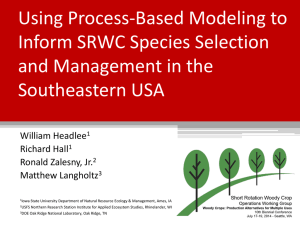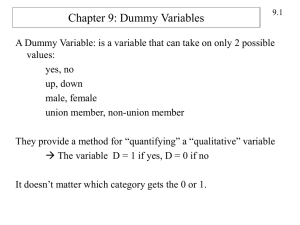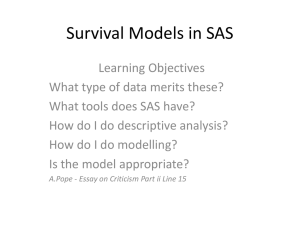Checking for Multicollinearity Using SAS
advertisement
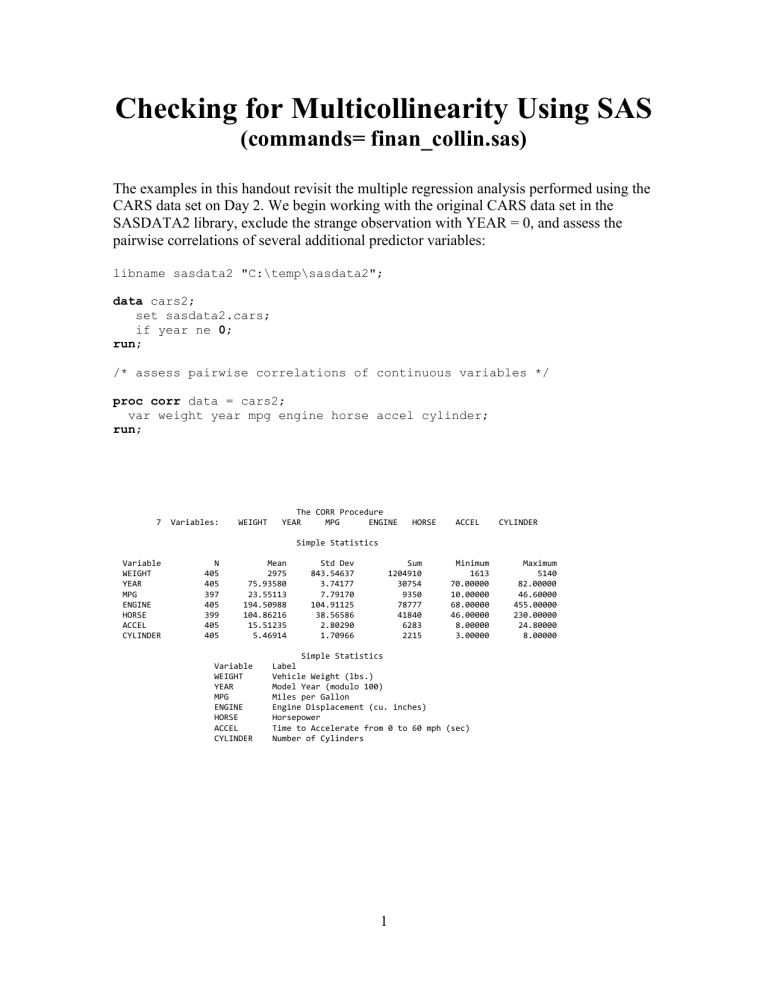
Checking for Multicollinearity Using SAS (commands= finan_collin.sas) The examples in this handout revisit the multiple regression analysis performed using the CARS data set on Day 2. We begin working with the original CARS data set in the SASDATA2 library, exclude the strange observation with YEAR = 0, and assess the pairwise correlations of several additional predictor variables: libname sasdata2 "C:\temp\sasdata2"; data cars2; set sasdata2.cars; if year ne 0; run; /* assess pairwise correlations of continuous variables */ proc corr data = cars2; var weight year mpg engine horse accel cylinder; run; 7 Variables: WEIGHT The CORR Procedure YEAR MPG ENGINE HORSE ACCEL CYLINDER Simple Statistics Variable WEIGHT YEAR MPG ENGINE HORSE ACCEL CYLINDER N 405 405 397 405 399 405 405 Mean 2975 75.93580 23.55113 194.50988 104.86216 15.51235 5.46914 Variable WEIGHT YEAR MPG ENGINE HORSE ACCEL CYLINDER Std Dev 843.54637 3.74177 7.79170 104.91125 38.56586 2.80290 1.70966 Sum 1204910 30754 9350 78777 41840 6283 2215 Minimum 1613 70.00000 10.00000 68.00000 46.00000 8.00000 3.00000 Simple Statistics Label Vehicle Weight (lbs.) Model Year (modulo 100) Miles per Gallon Engine Displacement (cu. inches) Horsepower Time to Accelerate from 0 to 60 mph (sec) Number of Cylinders 1 Maximum 5140 82.00000 46.60000 455.00000 230.00000 24.80000 8.00000 Pearson Correlation Coefficients Prob > |r| under H0: Rho=0 Number of Observations WEIGHT Vehicle Weight (lbs.) WEIGHT YEAR MPG ENGINE 1.00000 -0.30990 <.0001 405 -0.83014 <.0001 397 0.93335 <.0001 405 -0.30990 <.0001 405 1.00000 0.57608 <.0001 397 -0.37932 <.0001 405 -0.83014 <.0001 397 0.57608 <.0001 397 1.00000 -0.80388 <.0001 397 0.93335 <.0001 405 -0.37932 <.0001 405 -0.80388 <.0001 397 1.00000 0.86506 <.0001 399 -0.41946 <.0001 399 -0.77619 <.0001 391 0.89949 <.0001 399 -0.43847 <.0001 405 0.30753 <.0001 405 0.42775 <.0001 397 -0.56226 <.0001 405 0.89482 <.0001 405 -0.35706 <.0001 405 -0.77394 <.0001 397 0.95183 <.0001 405 405 YEAR Model Year (modulo 100) MPG Miles per Gallon ENGINE Engine Displacement (cu. inches) HORSE Horsepower ACCEL Time to Accelerate from 0 to 60 mph (sec) CYLINDER Number of Cylinders 405 Pearson Correlation Coefficients Prob > |r| under H0: Rho=0 Number of Observations HORSE 397 405 ACCEL CYLINDER 0.86506 <.0001 399 -0.43847 <.0001 405 0.89482 <.0001 405 YEAR Model Year (modulo 100) -0.41946 <.0001 399 0.30753 <.0001 405 -0.35706 <.0001 405 MPG Miles per Gallon -0.77619 <.0001 391 0.42775 <.0001 397 -0.77394 <.0001 397 ENGINE Engine Displacement (cu. inches) 0.89949 <.0001 399 -0.56226 <.0001 405 0.95183 <.0001 405 HORSE Horsepower 1.00000 -0.70885 <.0001 399 0.84355 <.0001 399 -0.70885 <.0001 399 1.00000 -0.52849 <.0001 405 0.84355 <.0001 399 -0.52849 <.0001 405 WEIGHT Vehicle Weight (lbs.) 399 ACCEL Time to Accelerate from 0 to 60 mph (sec) CYLINDER Number of Cylinders 405 1.00000 405 We note several extremely large positive and negative correlations, especially of the ENGINE variable with other possible predictors of MPG. Including several predictors in a multiple regression model that are highly correlated with each other (multicollinearity) can have an adverse effect on estimates of regression coefficients (signs may be flipped entirely) and their significance tests (standard errors tend to be “inflated” and are much 2 larger than they should be, relative to the case where predictors are not correlated). We consider fitting a regression model using all of these predictors of MPG: /* fit a regression model using all possible predictors */ proc reg data = cars2; model mpg = weight year engine horse accel cylinder; run;quit; The REG Procedure Model: MODEL1 Dependent Variable: MPG Miles per Gallon Number of Observations Read Number of Observations Used Number of Observations with Missing Values 405 391 14 Analysis of Variance DF Sum of Squares Mean Square 6 384 390 19070 4539.97495 23610 3178.30004 11.82285 Root MSE Dependent Mean Coeff Var 3.43844 23.48286 14.64233 Source Model Error Corrected Total R-Square Adj R-Sq F Value Pr > F 268.83 <.0001 0.8077 0.8047 Parameter Estimates Variable Label Intercept WEIGHT YEAR ENGINE Intercept Vehicle Weight (lbs.) Model Year (modulo 100) Engine Displacement (cu. inches) Horsepower Time to Accelerate from 0 to 60 mph (sec) Number of Cylinders HORSE ACCEL CYLINDER DF Parameter Estimate Standard Error t Value Pr > |t| 1 1 1 1 -14.31877 -0.00680 0.75456 0.00834 4.78551 0.00067085 0.05271 0.00747 -2.99 -10.14 14.31 1.12 0.0029 <.0001 <.0001 0.2647 1 1 -0.00200 0.07502 0.01417 0.10392 -0.14 0.72 0.8877 0.4708 1 -0.34586 0.33376 -1.04 0.3007 Results to note are highlighted in boldface. Despite the fact that ENGINE, HORSE, ACCEL, and CYLINDER all have significant bivariate correlations with MPG, none of them appear to be significant predictors of MPG based on the t-tests for their coefficients in the regression model. What’s happening here? We can assess collinearity diagnostics using additional options supplied to Proc Reg (vif, tol, and collin): /* refit model, and request collinearity diagnostics */ proc reg data = cars2; model mpg = weight year engine horse accel cylinder / vif tol collin; run; quit; 3 Parameter Estimates Variable Label Intercept WEIGHT YEAR ENGINE Intercept Vehicle Weight (lbs.) Model Year (modulo 100) Engine Displacement (cu. inches) Horsepower Time to Accelerate from 0 to 60 mph (sec) Number of Cylinders HORSE ACCEL CYLINDER DF Tolerance Variance Inflation 1 1 1 1 . 0.09416 0.80734 0.04964 0 10.62064 1.23864 20.14676 1 1 0.10298 0.36895 9.71021 2.71042 1 0.09382 10.65908 4 Collinearity Diagnostics Number Eigenvalue Condition Index 1 2 3 4 5 6 7 6.66806 0.28737 0.02426 0.00993 0.00500 0.00459 0.00080065 1.00000 4.81704 16.57992 25.90982 36.53406 38.12909 91.25974 ---------------Proportion of Variation--------------Intercept WEIGHT YEAR ENGINE 0.00002873 0.00047589 0.00295 0.00750 0.00298 0.01096 0.97510 0.00015625 0.00053364 0.00647 0.20868 0.53551 0.19390 0.05475 0.00004058 0.00083990 0.00357 0.01533 0.00061181 0.09026 0.88936 0.00022630 0.01247 0.06229 0.00060254 0.76121 0.16068 0.00252 Collinearity Diagnostics Number 1 2 3 4 5 6 7 ---------Proportion of Variation--------HORSE ACCEL CYLINDER 0.00026356 0.00388 0.25738 0.07830 0.02938 0.43904 0.19175 0.00023012 0.01143 0.07604 0.15214 0.14182 0.49405 0.12428 0.00018279 0.00119 0.02274 0.30804 0.31621 0.33015 0.02147 The tolerance (requested by the tol option) is the proportion of variance in a given predictor that is NOT explained by all of the other predictors, while the VIF (or Variance Inflation Factor) is simply 1 / tolerance. The VIF represents a factor by which the variance of the estimated coefficient is multiplied due to the multicollinearity in the model. In other words, the variance of the estimated coefficient for ENGINE is 20 times larger than it would be if the predictors were orthogonal (i.e., not correlated). A good “global” check for a multicollinearity problem is to see if the largest condition index is greater than 30. This is a general rule of thumb, and we definitely see a problem in this model. Predictors with large proportions of variation for eigenvalues that are very small (the last three eigenvalues in this case) tend to be highly correlated, and could possibly be combined rather than considered separately. At this point, one could arbitrarily choose one of a set of highly correlated predictors to retain in the model, or possibly combine the correlated predictors into a single variable (perhaps using a technique known as principal components analysis). We arbitrarily only include ENGINE as an additional predictor, and refit the model: /* refit model, including ENGINE only */ proc reg data = cars2; model mpg = weight year engine /*horse accel cylinder*/ / vif tol collin; run; quit; Parameter Estimates Variable Label Intercept WEIGHT YEAR ENGINE Intercept Vehicle Weight (lbs.) Model Year (modulo 100) Engine Displacement (cu. inches) DF Parameter Estimate Standard Error t Value Pr > |t| 1 1 1 1 -14.37464 -0.00684 0.76191 0.00148 3.99146 0.00057750 0.05082 0.00479 -3.60 -11.84 14.99 0.31 0.0004 <.0001 <.0001 0.7573 5 6 Parameter Estimates Variable Label Intercept WEIGHT YEAR ENGINE Intercept Vehicle Weight (lbs.) Model Year (modulo 100) Engine Displacement (cu. DF Tolerance Variance Inflation 1 1 1 1 . 0.12614 0.85080 0.11994 0 7.92792 1.17536 8.33762 We still see a problem with variance inflation due to the correlation of ENGINE with WEIGHT (to the point where WEIGHT does not seem to have a significant relationship with MPG), suggesting that our original model from yesterday would be sufficient. The largest condition index for this model was about 62. Be very wary of multicollinearity and its side effects when fitting multiple regression models using several continuous predictors! Centering variables (see Day 2 handout) can help, especially when working with interactions between continuous predictors. Fitting Regression Models Using SAS INSIGHT 1. Type “insight” into the command line dialog box in the SAS window to start SAS INSIGHT. 2. Select a defined library and a SAS data set to work with. 3. Select Analyze, and then Fit (Y X) to fit a regression model. 4. Select the dependent (Y) variable, and any independent (X) predictor variables that are defined in the SAS data set. Click OK to fit the model and generate estimates of the regression coefficients. 5. To investigate additional diagnostic plots after the model has been fitted, use the Graphs menu. In the case of simple linear regression, confidence curves can be drawn around the fitted line by using the Curves menu. 6. Additional tables of output (e.g., Collinearity Diagnostics) can be requested using the Tables menu. 7
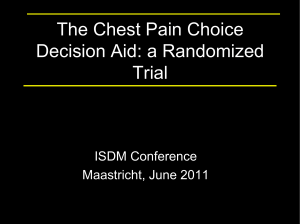

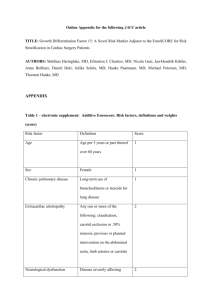

![Blair _Wormer_[NCSC_ACS_2013]](http://s3.studylib.net/store/data/005823715_1-199777ba9a38fe55b0950bba18d591a9-300x300.png)
